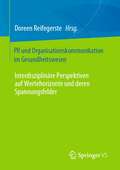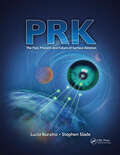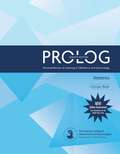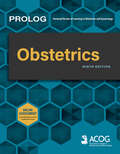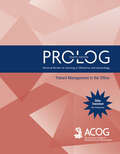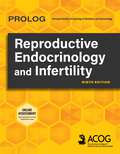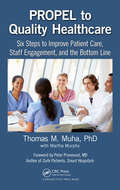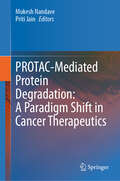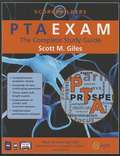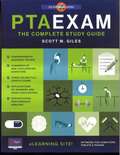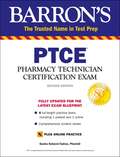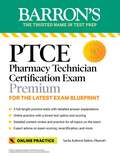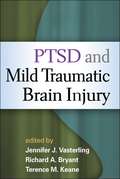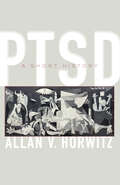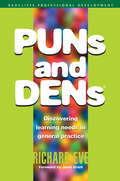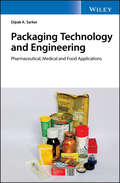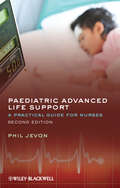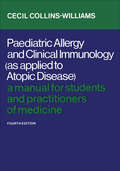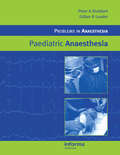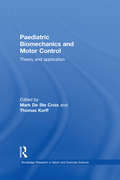- Table View
- List View
PR und Organisationskommunikation im Gesundheitswesen: Interdisziplinäre Perspektiven auf Wertehorizonte und deren Spannungsfelder
by Doreen ReifegersteDas Gesundheitssystem ist geprägt von medizinischen, gemeinwohlorientierten und ökonomischen Interessen. Diese Zielgrößen sind dabei vor dem Hintergrund gesellschaftlicher und systembezogener Wandlungsprozesse wie der Patientenorientierung und Digitalisierung zu bewerten. In der Gesamtschau ergibt dies ein Spannungsfeld konkurrierender und komplementärer Ziele in der internen und externen Kommunikation von Kliniken, Pharmaunternehmen, Krankenversicherungen und einzelner Akteure des Gesundheitswesens. Auf dieses Spannungsfeld geht dieser Band ein und integriert dabei die Perspektiven der PR-und Organisationskommunikation sowie der Gesundheitskommunikation.
PREPAREDNESS NOW!
by Aton EdwardsIn uncertain times, a solid preparedness plan is essential for every individual and family. PREPAREDNESS NOW! navigates the new realities of twenty-first century living: extreme weather, economic instability, terror attacks, and more.Packed with checklists, resources, and step-by-step instructions, PREPAREDNESS NOW! details everything needed for office, car, and home preparedness. This newly expanded and revised edition includes an extended chapter on food and water storage and urban gardening, techniques in personal defense, and the latest and best preparedness products on the market. This book encourages basic lifestyle changes that lead to a more self-sufficient and satisfying existence, regardless of circumstance.PREPAREDNESS NOW! is written by one of the most experienced preparedness experts in the field. Aton Edwards is executive director of the International Preparedness Network (IPN) and has worked with the Red Cross, NYPD, Center for Disease Control, and thousands of people domestically and overseas.This manual delivers practical advice on: Building your emergency kits for home, car, and office Water quality control and storage Emergency shelter, power, lighting, and heating Emergency transportation, communications, and evacuation Extreme weather preparedness Chemical, biowarfare, and nuclear preparedness Defense against infectious diseases Personal defense and crime prevention for the twenty-first century home
PRK: Past, Present, and Future
by Lucio Buratto Steven G. Slade Sebastiano Serrao Marco LombardoModern laser vision correction has continually changed since its inception. The evolution of this procedure has been aided by broad technological advancements, increased surgical knowledge, and increased understanding of the cornea and its response to lasers.PRK: The Past, Present, and Future of Surface Ablation will provide a complete vision of the PRK laser correction techniques that have emerged and the technological advancements that have made them possible. The collaboration of Drs. Buratto, Slade, Serrao, and Lombardo, along with a team of international surgeons have produced a complete book specifically designed to assist clinician’s to improve the quality of their patient’s visionWith over 85 color illustrations demonstrating the various procedures and concepts, the book will help ophthalmologists develop a more thorough understanding of PRK. PRK: The Past, Present, and Future of Surface Ablation is excellent for surgeons interested in learning the concepts, developing skills, and preparing for the actual laser procedure. This definitive resource couples both the authors' and 9 contributors' diverse experience and knowledge to produce a complete vision of PRK laser vision correction. PRK: The Past, Present, and Future of Surface Ablation will be the definitive resource necessary for all surgeons aspiring to improve their surgical results using the latest techniques available.
PROLOG: Assessment And Critique (Prolog)
by American College of Obstetricians and GynecologistsEach of the 6 units of PROLOG addresses a major area in obstetrics and gynecology and consists of two parts—an assessment book and a critique book. Put your knowledge to the test and earn 25 CME credits for this volume! The obstetrician–gynecologist who completes Obstetrics, Eighth Edition, should be able to:Demonstrate an understanding of maternal and fetal physiology and pathophysiology and their impact on normal and complicated pregnanciesIdentify components of antepartum care that optimize maternal and perinatal outcomes in uncomplicated pregnancies, including education regarding normal pregnancyDiagnose and plan efficacious and cost-effective management of medical and obstetric conditions encountered during the antepartum period.Identify the risks and prognosis of selected complications of pregnancy and in the neonateDescribe invasive and noninvasive methods of fetal assessment in the antepartum period and identify the risks, indications, predictive value, and physiologic basis for testsDiagnose problems and manage obstetric emergencies.Select appropriate management strategies for intrapartum care and deliveryConsider medical-legal principles, risk management and office management guidelines in obstetric practice.
PROLOG: Obstetrics, Ninth Edition (Prolog)
by American College of Obstetricians & Gynecologists College of AmericanPROLOG: Obstetrics is the premier learning tool for staying up to date in the specialty area. Consisting of an assessment and critique book, PROLOG is an effective, self-directed study resource and reference for both obstetricians– gynecologists and those in training. The content is peer-reviewed, current, and clinically relevant. Put your knowledge to the test and earn up to 25 CME credits with this volume.Upon successful completion, users of this unit will be able to:Demonstrate an understanding of maternal and fetal physiology and pathophysiology and the effects on normal and complicated pregnanciesIdentify components of antepartum care that optimize maternal and perinatal outcomes in uncomplicated pregnancies, including education regarding normal pregnancyDiagnose and plan efficacious and cost-effective management of medical and obstetric conditions encountered during the antepartum periodIdentify the risks and prognosis of selected complications of pregnancy and in the neonateDescribe antenatal genetic screening and diagnostic tests and identify the indications, risks, and predictive value for eachDiagnose problems and manage obstetric emergenciesSelect appropriate management strategies for intrapartum care and deliveryConsider medical-legal principles, risk management, and office management guidelines in obstetric practiceOrder PROLOG: Obstetrics, Ninth Edition, today!A complimentary, online study tool— PROLOG Games— is included with purchase of this print copy.
PROLOG: Patient Management in the Office, Eighth Edition (Prolog)
by American College of Obstetricians and GynecologistsPROLOG: Patient Management in the Office, Eighth Edition, is the premier learning tool for staying up-to-date in obstetrics and gynecology. Consisting of an assessment and critique book, PROLOG is an effective, self-directed study resource and reference for both obstetrician–gynecologists and those in training. The content is peer-reviewed, current, and clinically relevant. Put your knowledge to the test and earn 25 CME credits with this volume.
PROLOG: Reproductive Endocrinology and Infertility, Ninth Edition (Prolog)
by American College of Obstetricians & GynecologistsPROLOG: Reproductive Endocrinology and Infertility, Ninth Edition, is the premier resource for staying up to date in this specialty area. Consisting of critique and assessment sections, PROLOG offers an effective, self-directed study experience for obstetrician–gynecologists and those in training. The content is current, relevant, and written and reviewed by experts in the field. Put your knowledge to the test and earn 25 CME credits with this volume. Upon completing this unit, learners should be able to: • Identify appropriate tests for endocrinology and infertility conditions. • Determine the appropriate medical management to address infertility. • Apply the concepts of the hypothalamic-pituitary-ovarian-uterine axis when considering medication. • Understand the basics of assisted reproductive technology. • Counsel women regarding treatment options for primary and secondary amenorrhea and infertility. Purchase PROLOG: Reproductive Endocrinology and Infertility, Ninth Edition, today to advance your knowledge and enhance your practice. A complimentary, online study tool, PROLOG Games, is included with purchase of the printed book.
PROPEL to Quality Healthcare: Six Steps to Improve Patient Care, Staff Engagement, and the Bottom Line
by Thomas M Muha Martha MurphyYou got into healthcare because you wanted to help people, but quickly discovered providing high-quality care is challenging. Seemingly impossible demands are placed on you and your team. Some coworkers are constantly complaining; others are in their silos doing only what they must to get through the long days. Collaboration is often lacking, and patients suffer the painful consequences. It’s easy to become overloaded with work and overwhelmed with negativity. This is not how the healthcare profession has to be. There is a new science – Positive Psychology – that studies how people are able to perform extraordinarily well in challenging situations. After a dozen years of research in prestigious medical centers, an evidence-based method for applying this science has been developed. That six step program is PROPEL. You will read stories illustrating the experiences of doctors, nurses and administrators who learned to use PROPEL to transform their professional life (and, for many, their personal life as well). You will learn how they were able to attain remarkable results with their teams, units and clinics: • Staff callout and FMLA decreased 75% • Wait times for chemotherapy infusion reduced 6 hours • Staff turnover dropped 80% • Pediatric MRI scheduling driven down from 14 weeks to 10 days • Bone marrow transplant procedures increased by 50% • ED diversion due to psychiatric patient boarding virtually eliminated • Patient fall rate cut by 70% • Use of agency and travelers nurses abolished • Patient satisfaction scores up 50% The cumulative impact to the bottom line has been calculated to be millions of dollars. The most meaningful measure of PROPEL’s success, however, comes from the thousands of dedicated professionals who have expressed heartfelt gratitude for having learned how to recapture their joy for working in healthcare.
PROTAC-Mediated Protein Degradation: A Paradigm Shift in Cancer Therapeutics
by Mukesh Nandave Priti JainThis book is a comprehensive coverage of the ubiquitin-proteasome system and its involvement in cancer progression, and the application of PROTACs in different types of cancer treatment. The book discusses a unique perspective and comprehensive knowledge of the potential of PROTACs to transform cancer therapies. It provides an overview of the history, mechanisms, chemistry, design considerations, and different technologies involved in PROTACs. Additionally, it explains the ubiquitin-proteasome system, its impact on various diseases, and the principles and mechanisms of UPS. The book also describes the chemistry and design aspects of PROTACs and their role in various types of cancers. Finally, it covers the pharmaceutics aspect of formulation design, global requirements, and toxicological aspects of PROTACs. This book is targeted at cancer researchers, medical oncologists, bioinformatics, computational biologists, pharmacologists, medicinal chemists, formulation scientists, regulatory authorities, and policy makers.
PTAEXAM: The Complete Study Guide
by Scott M. Giles"Perhaps the most valuable piece of Information a candidate can utilize when preparing for the National Physical Therapist Assistant Examination is the National Physical Therapist Assistant Examination Blueprint. The blueprint provides a detailed analysis of each of the content areas of the National Physical Therapist Assistant Examination. A thorough understanding of the content outline and system specific weighting will streamline a candidate's preparation. Less time will be spent covering topics that are not clinically relevant to the actual examination and as a result, more time will be available for reviewing and relearning. Perhaps the most valuable piece of Information a candidate can utilize when preparing for the National Physical Therapist Assistant Examination is the National Physical Therapist Assistant Examination Blueprint. The blueprint provides a detailed analysis of each of the content areas of the National Physical Therapist Assistant Examination. A thorough understanding of the content outline and system specific weighting will streamline a candidate's preparation. Less time will be spent covering topics that are not clinically relevant to the actual examination and as a result, more time will be available for reviewing and relearning.
PTAEXAM: The Complete Study Guide
by Scott M. GilesScorebuilders compete study guide to the PTA Exam- by Scott M. Giles. -Comprehensive academic review -Hundreds of new challenging questions -Three online full length exams - Explanations of correct and incorrect answers - Sophisticated performance analysis
PTCE - Pharmacy Technician Certification Exam Flashcard Book + Online
by Della Ata KhouryPTCE (Pharmacy Technician Certification Exam) Flashcard Book400 Questions & Answers You Need to KnowWritten by a seasoned pharmacy technician instructor, this PTCE study supplement covers everything you need to know for the exam: assisting the pharmacist in serving patients, maintaining medication and inventory control systems, and participating in the management of pharmacy practice.The 400 flashcards are broken down by PTCE test topics and include multiple-choice questions with detailed answers. We give you:100 flashcards focused on the top 100 brand/generic drug names including their drug classes, indications, side effects, and special considerations; 50 flashcards focused on pharmaceutical terms and abbreviations and 250 flashcards focused on PTCE review material: Assisting the Pharmacist in Serving Patients (165 flashcards), Maintaining Medication and Inventory Control Systems (50 flashcards), and Participating in the Administration and Management of Pharmacy Practice (30 flashcards).After studying with the book, review what you've learned at REA's online Study Center. Customizable e-flashcards and 3 practice quizzes let you create your own PTCE study plan and study anywhere, anytime. You can also make your own flashcards for any topics that give you difficulty.If you're a pharmacy tech student and want extra practice and review before the exam, REA's PTCE Flashcard Book is the right Rx for your study needs.
PTCE - Pharmacy Technician Certification Exam Flashcard Book + Online (Flash Card Books)
by Della Ata KhouryREA's PTCE (Pharmacy Technician Certification Exam) Flashcard BookUpdated Second Edition500 Questions & Answers You Need to KnowThis latest addition to our Health Sciences series of flashcards is designed to help PTCE candidates check their test-readiness before taking the Pharmacy Technician Certification Exam. Unlike most flashcards that come in a box, our cards are bound in an easy-to-use, organized book that makes it convenient to study anywhere.Written by a seasoned pharmacy technician instructor and based on the most recent exam, our study supplement covers everything you need to know for the PTCE: assisting the pharmacist in serving patients, maintaining medication and inventory control systems, and participating in the management of pharmacy practice.The flashcards are broken down by PTCE test topics and include multiple-choice questions with detailed answer explanations. The questions are similar to what you may encounter on the PTCE. The 500 flashcards are divided as follows:* 200 flashcards focused on the top 200 brand/generic drug names including their respective drug classes, indications, side effects, and special considerations* 50 flashcards focused on pharmaceutical terms and abbreviations* 250 flashcards focused on PTCE review material:- 165 flashcards on Assisting the Pharmacist in Serving Patients- 55 flashcards on Maintaining Medication and Inventory Control Systems- 30 flashcards on Participating in the Administration and Management of Pharmacy PracticeAfter studying with the book, go online and review what you have learned at REA's Study Center. Our customizable e-flashcards and 3 practice quizzes give you the freedom to create your own PTCE study plan and study anywhere, anytime. You can also create your own unique flashcards for any sections of the test that give you difficulty.This flashcard book and the online tools that come with it, will help you personalize your PTCE prep by testing your understanding, pinpointing your weaknesses, and delivering flashcard study materials unique to you.If you're a pharmacy tech student and want extra practice and review before the exam, REA's PTCE Flashcard Book is the right Rx for your study needs.
PTCE with Online Test: Pharmacy Technician Certification Exam (Barron's Test Prep)
by Sacha Koborsi-Tadros PharmDBarron’s PTCE with Online Test: Pharmacy Technician Certification Exam contains all of the latest information about upcoming changes to the PTCE exam scheduled to go into effect in January 2020. You’ll get detailed review, full-length practice tests, and answer explanations to help you master the material and pass the exam. This updated edition will be aligned with the 2020 test change and features: Two full-length practice tests in the book with detailed answer explanations, One additional full-length practice exam online with detailed explanations, A full-length pretest designed to help you assess your strengths and weaknesses before beginning your review, Review content that covers all of the major topic areas and knowledge domains of the latest official PTCE blueprint, Hundreds of practice questions with detailed answer explanations for extra preparation, All of the latest information about pharmacy technician certification requirements, PTCE scoring, steps for scheduling the PTCE, and test-taking skills, important tips, and winning strategies
PTCE: Pharmacy Technician Certification Exam Premium: 4 Practice Tests + Comprehensive Review + Online Practice (Barron's Test Prep)
by Sacha Koborsi-Tadros PharmDBarron&’s PTCE: Pharmacy Technician Certification Exam includes in-depth content review and online practice. It&’s the only book you&’ll need to be prepared for exam day.Written by Experienced EducatorsLearn from Barron&’s--all content is written and reviewed by instructors who have vast experience teaching pharmacy technician courses to prepare students for certificationBuild your understanding with comprehensive review tailored to the most recent exam blueprintGet a leg up with tips, strategies, and advice for scheduling your exam, exam day itself, and recertification--it&’s like having a trusted tutor by your sideBe Confident on Exam DaySharpen your test-taking skills with 4 full-length practice tests--3 in the book (including a pretest to target your studying), and 1 more online Strengthen your knowledge with in-depth review covering all major topics and knowledge domains on the latest exam blueprintReinforce your learning with practice questions at the end of each chapterExpand your review with a series of appendices that cover the top 200 medications, common vitamins and natural supplements, frequently used pharmacy abbreviations and medical terminology, and much moreOnline PracticeContinue your practice with 1 full-length practice test on Barron&’s Online Learning HubSimulate the exam experience with a timed test optionDeepen your understanding with detailed answer explanations and expert adviceGain confidence with scoring to check your learning progress
PTSD and Mild Traumatic Brain Injury
by Jennifer VasterlingEvents that lead to traumatic brain injury are often also psychologically traumatic. Addressing a growing need among mental health practitioners, this authoritative book brings together experts in both posttraumatic stress disorder (PTSD) and mild traumatic brain injury (mTBI). Chapters present empirically based best practices for conceptualization, assessment, and intervention. The book also addresses the biological and psychosocial mechanisms by which PTSD and mTBI complicate each other; management of commonly associated conditions, including chronic pain and substance abuse; special considerations in military contexts; and possible ways to improve the structure and cost-effectiveness of providing care in this challenging area.
PTSD and the Politics of Trauma in Israel: A Nation on the Couch
by Hebrew University Magnes Press Keren Friedman-PelegPost-Traumatic Stress Disorder, or PTSD, has long been defined as a mental trauma that solely affects the individual. However, against the backdrop of contemporary Israel, what role do families, health experts, donors, and the national community at large play in interpreting and responding to this individualized trauma? In PTSD and the Politics of Trauma in Israel, Keren Friedman-Peleg sheds light on a new way of speaking about mental vulnerability and national belonging in contemporary Israel. Based on ethnographic fieldwork conducted at The Israel Center for Victims of Terror and War and The Israel Trauma Coalition between 2004 and 2009, Friedman-Peleg’s rich ethnographic study challenges the traditional and limited definitions of trauma. In doing so, she exposes how these clinical definitions have been transformed into new categories of identity, thereby raising new dynamics of power, as well as new forms of dialogue.
PTSD: A Short History (Johns Hopkins Biographies of Disease)
by Allan V. HorwitzA comprehensive history of PTSD.Post-traumatic stress disorder—and its predecessor diagnoses, including soldier’s heart, railroad spine, and shell shock—was recognized as a psychiatric disorder in the latter part of the nineteenth century. The psychic impacts of train crashes, wars, and sexual shocks among children first drew psychiatric attention. Later, enormous numbers of soldiers suffering from battlefield traumas returned from the world wars. It was not until the 1980s that PTSD became a formal diagnosis, in part to recognize the intense psychic suffering of Vietnam War veterans and women with trauma-related personality disorders. PTSD now occupies a dominant place in not only the mental health professions but also major social institutions and mainstream culture, making it the signature mental disorder of the early twenty-first century. In PTSD, Allan V. Horwitz traces the fluctuations in definitions of and responses to traumatic psychic conditions. Arguing that PTSD, perhaps more than any other diagnostic category, is a lens for showing major historical changes in conceptions of mental illness, he surveys the conditions most likely to produce traumas, the results of those traumas, and how to evaluate the claims of trauma victims. Illuminating a number of central issues about psychic disturbances more generally—including the relative importance of external stressors and internal vulnerabilities in causing mental illness, the benefits and costs of mental illness labels, and the influence of gender on expressions of mental disturbance—PTSD is a compact yet comprehensive survey. The book will appeal to diverse audiences, including the educated public, students across the psychological and social sciences, and trauma victims who are interested in socio-historical approaches to their condition.Praise for Allan V. Horwitz’s Anxiety: A Short History"The definitive overview of the history of anxiety."—Bulletin of the History of Medicine"A lucid, erudite and brisk intellectual history driven by a clear and persuasive central argument."—Social History of Medicine"An enlightening tour of anxiety, set at a sensible pace, with an exceptional scholar and writer leading the way."—Library Journal
PUNs and DENs: Discovering Learning Needs in General Practice
by Richard EveWith the introduction of yearly appraisals and revalidation every general practitioner needs to be armed with a good Personal Development Plan. This book provides the information needed to create just that. Guiding the reader through the consultation looking for Patient's Unmet Needs (PUNs) and the Doctor's Educational Needs (DENs), it focuses on those learning needs that help to provide competent care for patients. All general practitioners will find this book a straightforward, no nonsense, practical approach to help them incorporate their learning needs into the realities of everyday practice.
Packaging Technology and Engineering: Pharmaceutical, Medical and Food Applications
by Dipak Kumar SarkerCovers chemistry, physics, engineering, and therapeutic aspects of packaging—universal to pharmaceutical, medical, and food applications This book covers the chemistry, physics, materials science, engineering, and therapeutic aspects of many different types of packaging materials, emphasizing throughout the applicability of various aspects of packaging science and technology. It also provides a simultaneous discussion of interrelated fields, and addresses the universal issues within these fields’ application areas. Intended as a technical reference and as a study aid, it is relevant to anyone who studies or uses packaging or packaging materials. Packaging Technology and Engineering: Pharmaceutical, Medical and Food Applications begins with an overview of the history of the topic. It then offers chapters on the methods of obtaining raw materials, the chemistry of polymeric and non-polymeric packaging materials, physico-chemical quality parameters, and the manufacturing of packaging. Other topics look at: additives, use, suppliers, safety and environmental concerns, regulation, anti-fraud activities, new trends, and the future of packaging technology. The book also features numerous problems and worked solutions to aid student comprehension. Covers packaging and packaging materials, their properties and technologies Addresses the chemical engineering, physics, and chemistry of packaging materials, and the individual requirements for food, pharmaceutical, and medical device packaging Includes current issues such as environmental concerns and sustainability, recycling and after-use, anti-counterfeiting technology, and packaging regulations and guidelines Packaging Technology and Engineering: Pharmaceutical, Medical and Food Applications will appeal to all packaging technologists, scientists, and engineers in industry, and in regulatory agencies. It is also an excellent book for advanced students studying packaging courses, within pharmacy, pharmaceutical sciences, chemical sciences, biomedical sciences, medical sciences, engineering, product design and technology, and food science/technology.
Packing for Mars: The Curious Science of Life in Space
by Mary RoachWhat happens when you vomit during a space walk? The bestselling author of Stiff explores the irresistibly strange universe of space travel and life without gravitySpace is devoid of the stuff humans need to live: air, gravity, hot showers, fresh veg, privacy, beer. How much can a person give up? What happens when you can't walk for a year? Is sex any fun in zero gravity? What's it like being cooped up in a metal box with a few people for months at a time? As Mary Roach discovers, it's possible to explore space without ever leaving Earth. From the space shuttle training toilet to a 17,000 mile-per-hour crash test of NASA's space capsule (cadaver stepping in), she takes us on a surreally entertaining trip into the science of living in space.
Paediatric Advanced Life Support: A Practical Guide for Nurses
by Philip JevonIn the event of a paediatric cardiac arrest, it is essential to be able to respond rapidly, providing safe and effective care. The second edition of this successful text provides nurses with a practical and systematic guide to the rapid assessment and delivery of appropriate resuscitation to infants and children. Conforms to current European Resuscitation Council Guidelines Based on up-to-date research and evidence-based practice protocols Synoptic approach enables rapid delivery of effective treatment Written by experts in the field of both resuscitation and paediatrics Paediatric Advanced Life Support is a succinct yet comprehensive guide and is an essential purchase for any health professional likely to encounter an emergency situation.
Paediatric Allergy and Clinical Immunology (As Applied to Atopic Disease): A Manual for Students and Practitioners of Medicine (Fourth Edition)
by Cecil Collins-WilliamsThis is a practical reference volume for the student or practising physician to aid him in the investigation, diagnosis, and treatment of allergy in children. It is based on procedures used at The Hospital for Sick Children in Toronto, Canada. In this new fourth edition, material has been added and established treatments up-dated. The allergies to which children are subject are discussed in clear, straightforward language, as are the basic principles of atopic disease. There are sections on prophylaxis of allergy, common mistakes in the care of the allergic patient, the optimistic approach to the care of the allergic patient, anaphylaxis in man, and the immunoglobulins. Each section is documented. Four appendices offer various diets and discuss immunological deficiency diseases, beta adrenergic blockade, and the pathophysiology of asthma.
Paediatric Anaesthesia
by Peter A Stoddart Gillian R LauderIncreasingly diverse conditions now treated surgically combined with developments in technology have made the field of pediatric anesthesia more complex. Even common medical problems may give rise to difficult decisions. This has created a need for a resource that covers the latest techniques in the field. Authoritative and comprehensive, Problems
Paediatric Biomechanics and Motor Control: Theory and Application (Routledge Research in Sport and Exercise Science)
by Mark De Ste Croix Thomas KorffPaediatric Biomechanics and Motor Control brings together the very latest developmental research using biomechanical measurement and analysis techniques and is the first book to focus on biomechanical aspects of child development. The book is divided into four main sections – the biological changes in children; developmental changes in muscular force production; developmental changes in the biomechanics of postural control and fundamental motor skills and finally the applications of research into paediatric biomechanics and motor control in selected clinical populations. Written by a team of leading experts in paediatric exercise science, biomechanics and motor control from the UK, the US, Australia and Europe, the book is designed to highlight the key implications of this work for scientists, educators and clinicians. Each chapter is preceded by a short overview of the relevant theoretical concepts and concludes with a summary of the practical and clinical applications in relation to the existing literature on the topic. This book is important reading for any sport or exercise scientist, health scientist, physical therapist, sports coach or clinician with an interest in child development or health.
